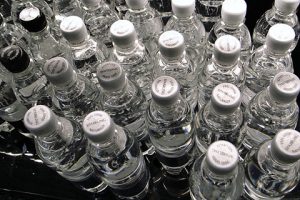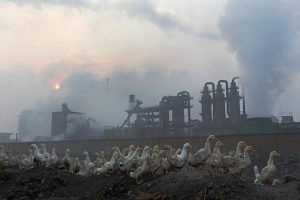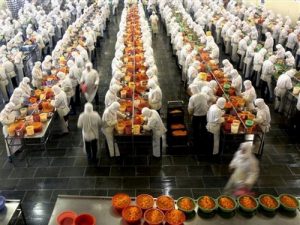Deep-fried dough sticks, steamed buns, noodles and cold jellyfish – it’s a pretty ordinary day’s menu for a Chinese diner, but it brings with it the risk of over-exposure to aluminium.
On July 1, three aluminium-containing additives were banned from use in the food industry, while potassium alum will no longer be permitted in non-fried foods. There is also a total ban on aluminium in puffed-grain products.
The move follows mounting evidence that Chinese people are eating too much of the toxic heavy metal, with serious impacts on health and child development. On June 16, the China National Center for Food Safety Risk Assessment (CFSA) published China’s first major report on the problem, which found that almost a third of the population is ingesting more aluminium than is considered safe. In the north of the country, the figures are worse still, with 60% of people at risk of consuming too much aluminium.
In tests on more than 6,600 food products commonly made with aluminium-containing additives, the CFSA found aluminium levels exceeding the legal limit of 100 milligrammes (mg) per kilogrammes (kg) in 40% of cases. Youtiao – the deep-fried dough sticks typically eaten at breakfast – breached the limit by 72%, and steamed buns by 28%.
Other products made from flour are also likely to contain too much aluminium. Jellyfish is processed using potassium alum, and consequently is the worst offender in terms of percentage of samples containing unacceptable levels of the heavy metal. Excess aluminium was present in every single sample of jellyfish tested by the CFSA, in one case at 346 times permissible levels.
The report blamed aluminium-containing additives for 75% of the aluminium found in foods. These additives are used to increase the speed at which steamed and baked bread products rise, as anti-caking agents in powdered or granulated products and as colourings in sugar-coatings.
The new regulations, which ban use of sodium aluminium phosphate, sodium aluminium silicate and starch aluminum octenyl succinate, should greatly reduce the use of such additives in foodstuffs. But Ji Heli, secretary of the Shanghai Food Additives Trade Association, says this may not fully address the problem: while the national standards will better control the obvious sources of aluminium, “hidden sources of aluminium are everywhere and very hard to control,” says Ji.
Children most at risk
Children are most vulnerable to aluminium exposure. According to the CFSA’s report, 70% of children under 14 ingest too much aluminium. Among four-to-six year-olds, the figure is 43% nationally, rising to 80% in the north of the country.
Puffed-grain snacks are the main culprit, explains CFSA researcher Ma Ning. Tests carried out by the School of Food Sciences at the China Agricultural University found one third of common puffed grain products contained too much aluminium.
Excess aluminium can harm the central nervous system. Impacts include developmental problems in babies and young children, which can for example lead to learning difficulties.
The good news is that it can be brought down to safe levels: “There’s no such thing as a safe substance, it’s how big a dose you get that determines whether or not it’s harmful,” says Ma Ning. “One less steamed bun, one less youtiao, one less bag of crisps for the kids, and you can bring aluminium intake under control.”
The CFSA predicts that if the new standards are rigorously enforced aluminium intake in China will drop by 86%, with the percentage of people in the north of China absorbing too much of the metal dropping from 60% to 20%. But how rigorous will it be?
The new rules include an exception for youtiao, cakes and batter – rather than a total ban on aluminium in these products, there is just an upper limit of 100mg per kg. Moreover, Ji Heli points out that while the standards target licensed manufacturers, small-scale producers are responsible for the most serious breaches.
At China’s annual parliamentary session this year, people’s representative Yao Juan, who is also head of research and development at yeast-manufacturer Angel Yeast, proposed that the government place a total ban on potassium alum and ammonium alum in food. “If the state could supervise all the small-scale producers there’d be no need for a total ban. But if it can’t, it’s very likely that standards will still be breached,” Yao said.
Some experts say that China’s large manufacturers are already very careful about using aluminium-containing additives. Many use biological raising agents as an alternative, or apply mechanical techniques to achieve the same effect. “Only a few small firms are still using these additives,” says Zhao Yanping, secretary of the Puffed Foods Expert Committee. Zhang Guozhi, head of the Department of Food Sciences at Henan Industrial University agrees: “legitimate producers won’t break the rules.”
But not using additives increases costs significantly. The aluminium-free raising agent developed by Yao Juan’s company costs 6 yuan (US$1) per kilogramme, compared to just 1 yuan (US$0.16) for potassium alum.
Huang Xiantang, honorary president of the Zhejiang Food Additives Association, worries such cost differences mean a ban on aluminium-containing additives could perversely lead to an increase in use, as happened when bleaching agents were outlawed in flour production. “For a time after the ban on bleaching agents, sales actually went up,” Huang explains. "As the big companies had to follow the rules, their costs rose, and that meant more sales for the small-scale producers who were still using bleaching agents.”
Originally published in Southern Weekend







